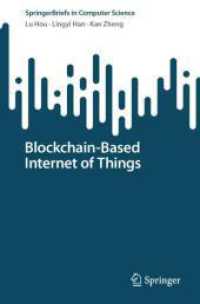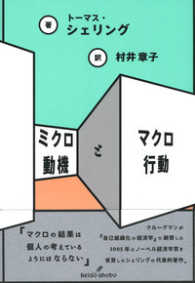Full Description
Audience: Reference for K-12 PE and classroom teachers, directors, principals, and administrators overseeing physical activity programs and wellness policy compliance. Text for college PE majors and elementary classroom education majors. Also a reference for community youth program leaders.
Physical activity doesn't have to be confined to physical education class. Many schools are discovering the benefits of incorporating physical activity throughout the day. In fact, schools increasingly need to do so as requirements for weekly minutes of physical activity expand beyond the time available for physical education class.
With Schoolwide Physical Activity: A Comprehensive Guide to Designing and Conducting Programs, K-12 classroom teachers and administrators will learn how to design and conduct activity programs that not only meet wellness policy requirements and goals but also motivate and encourage all students to be physically active.
The premise of this innovative guide is that physical activity in schools is not the sole responsibility of the PE teacher. It is the responsibility of all administrators and teachers—and is most successful when it is integrated throughout the curriculum.
To that end, Schoolwide Physical Activity highlights the role of elementary classroom teachers in providing opportunities for physical activity, and it offers an array of tools and programs for teachers to incorporate in their classrooms. At the secondary level, the book creates a vision of a good physical activity program and then shows secondary teachers and administrators how to achieve that vision. Through this text, teachers and administrators receive
• a blueprint for building a comprehensive and coordinated K-12 physical activity program;
• ready-to-use activities and forms; and
• program ideas that address both the needs and desires of all children, not just the small percentage who gravitate toward physical activity.
Schoolwide Physical Activity comes with a CD-ROM that contains all the printable activities, forms, and tools from the book and over 200 activities for classroom teachers, inclusive transitional activities, integrated lessons, and simple games and dances. The comprehensive guide includes a Web site with an instructor guide, presentation package, and test package.
This resource will help teachers and administrators see their roles and responsibilities in a new light and gain stakeholder support for wellness and activity programs, and it will assist in coordinating efforts among all involved in providing students with safe and appropriate programs that will transform their schools into more active places for learning.
Contents
Part I: Introduction
Chapter 1. Physical Activity and the School Program
The Problem
The Contributions of Physical Activity
Physical Activity, Exercise, and Fitness
Factors That Affect Physical Activity
National Recommendations for Physical Activity
The Solution
Physical Education and the School Physical Activity Program
Summary
Checking Your Understanding
Resources
References
Chapter 2. The School Wellness Program and Physical Activity
State-, District-, and School-Level Response
Gaining Stakeholder Support
The Role of School Administrators and Teachers
Developing a School Wellness Plan
Successful Ideas for a School Wellness Program
Barriers and Common Struggles in Implementing School Wellness Programs
Summary
Checking Your Understanding
Resources
References
Part II: The Elementary Physical Education Program
Chapter 3. Quality Elementary Physical Education
The Role of the School Administration in the Physical Education Program
The Role and Responsibilities of the Physical Education Teacher in the School Physical Activity Program
Physical Education's Contribution to the Domains of Learning
Curriculum Scope and Sequence
Factors That Affect the Development of Motor Skills
Developmentally Appropriate and Age-Related Curriculum
Movement Concepts
Locomotor Skills
Manipulative and Game Skills
Educational Gymnastics
Educational Dance Experiences
Organizing and Managing the Physical Education Learning Environment
Summary
Checking Your Understanding
Resources
References
Chapter 4. The Elementary School Physical Activity Program
The Need for Physical Activity for Elementary-Aged Children
A Word of Caution: Short-Term Versus Long-Term Effects
What Is a Comprehensive Elementary School Physical Activity Program?
The School Physical Activity Program: Who's Responsible?
Designing and Maintaining Safe and Age-Appropriate Playgrounds and Outdoor Areas
Summary
Checking Your Understanding
Resources
References
Chapter 5. The Role of the Classroom Teacher in Physical Activity Programs
Providing Opportunities for Physical Activity
Physical Activity as a Routine
Promoting Physically Active Lifestyles
Promoting Quality Health and Nutritional Habits
Working With the School Wellness Committee
Being a Physically Active and Healthy Role Model
Summary
Checking Your Understanding
Resources
References
Chapter 6. Recess
Contributions of Recess
Recommendations of Policy Groups for Recess
Encouraging Active Play
Scheduling Recess
Teaching Children Playground Games
Equipment for Recess
Designating Play Areas
Supervising the Playground
Summary
Checking Your Understanding
Resources
References
Chapter 7. Games in the Elementary School
Games in Physical Education Class
Low Organization Games
Factors That Affect the Selection of Appropriate and Safe Experiences for Children
Modifying Games
Child-Designed Games
Organizing and Conducting Games
Additional Game Opportunities
Summary
Checking Your Understanding
Resources
References
Chapter 8. Teaching Dance and Rhythms
Folk Dance
Line Dancing
Creative Dance
Coordinating Dances to Enhance Grade-Level Curriculum
Handling the Management Issues Related to Dance
Summary
Checking Your Understanding
Resources
Chapter 9. Fitness for the Elementary School Child
What Is Physical Fitness?
Exercise Principles for Developing Fitness
Harmful Exercises and Safe Alternatives
Approaching Fitness Positively
Health-Related Fitness Testing
Appropriate Fitness Activities for Children
Creating a Safe and Supportive Environment
Summary
Checking Your Understanding
Resources
References
Chapter 10. Administering the Elementary School Physical Activity Program
Who Is Responsible for the Physical Activity Program of the School?
Analyzing the Opportunities for Participation and the Level of Participation
Scheduling Activities of the Program
Budget
Planning the Program
Staffing the Program
Reinforcing Participation
Evaluating Your Program
Summary
Checking Your Understanding
Resources
Chapter 11. Programs Before, During, and After School and Special Events
To Structure or Not to Structure
Administrative Duties of the Program
Providing a Variety of Opportunities
Planning Events in Advance
Summary
Checking Your Understanding
Resources
References
Part III: The Secondary Physical Activity Program
Chapter 12. The Comprehensive Physical Activity Program for the Secondary School
What Are the Needs of the Secondary Student?
How Did We Get Here?
School Wellness Policies
The School Physical Activity Program: Physical Education
The School Physical Activity Program: Interscholastic Sport
Scheduling the Physical Activity Program
Involving the Community and Mandating Physical Activity
The School Physical Activity Program: A Comprehensive Perspective
The Physical Activity Director of the Secondary Program
Administrative Support
One Size Does Not Fit All
Summary
Checking Your Understanding
Resources
References
Chapter 13. Planning the Secondary Physical Activity Program
The Goals of an Inclusive Program
Determining Student Needs and Interests
What Facilities Do We Have and Need?
What Equipment Do I Need?
Structuring the Program
Staffing the Physical Activity Program
Promoting the Program
Summary
Checking Your Understanding
Resources
References
Chapter 14. Administering the Physical Activity Program
Establishing a Required Program
Administering Required and Voluntary Physical Activity Programs
Awards
Summary
Checking Your Understanding
Resources
References
Chapter 15. Conducting Intramural Sports
When to Hold Intramurals?
Modifying Play
Student Leadership
Organizing the Competition
Standards for Participant Behavior
Summary
Checking Your Understanding
Resources
References
Chapter 16. Conducting Secondary Heath-Related Fitness Programs
Components of Health-Related Fitness
Programming for Secondary Fitness Activities
Leadership for the Fitness Components of the Program
Summary
Checking Your Understanding
Resources
References
Part IV: Wellness Programs
Chapter 17. Parent, Staff, and Faculty Physical Activity Programs
What Is a School Staff, Faculty, and Parent Wellness Program?
Working With the Adult Population
Family Programs
Summary
Checking Your Understanding
Resources
Web Sites
Index
About the Authors
CD-ROM User Instructions








